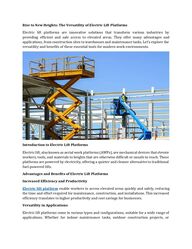
Return to flip book view
Rise to New Heights: The Versatility of Electric Lift Platforms Electric lift platforms are innovative solutions that transform various industries by providing efficient and safe access to elevated areas. They offer many advantages and applications, from construction sites to warehouses and maintenance tasks. Let's explore the versatility and benefits of these essential tools for modern work environments. Introduction to Electric Lift Platforms Electric lift, also known as aerial work platforms (AWPs), are mechanical devices that elevate workers, tools, and materials to heights that are otherwise difficult or unsafe to reach. These platforms are powered by electricity, offering a quieter and cleaner alternative to traditional fuel-powered lifts. Advantages and Benefits of Electric Lift Platforms Increased Efficiency and Productivity Electric lift platform enable workers to access elevated areas quickly and safely, reducing the time and effort required for maintenance, construction, and installations. This increased efficiency translates to higher productivity and cost savings for businesses. Versatility in Applications Electric lift platforms come in various types and configurations, suitable for a wide range of applications. Whether for indoor maintenance tasks, outdoor construction projects, or
warehouse operations, there's a lift platform designed to meet specific needs and requirements. Safety Features and Regulations Safety is a top priority when using lift platforms. These platforms have safety features such as guardrails, emergency stop buttons, and automatic descent systems to protect workers from falls and accidents. Additionally, strict regulations and standards govern the use of lift platforms to ensure safe operation. Environmental Considerations Electric lift platforms offer environmental benefits compared to fuel-powered alternatives. They produce zero emissions during operation, contributing to cleaner air quality and reducing the carbon footprint of worksites. This eco-friendly aspect is essential in indoor settings and environmentally sensitive areas. Types of Electric Lift Platforms Electric lift platforms come in several types, each designed for specific tasks and environments: • Scissor Lifts: Ideal for vertical lifting in indoor and outdoor settings, providing stability and platform extension capabilities. • Boom Lifts: Suitable for tasks requiring horizontal outreach, such as building maintenance, window cleaning, and tree trimming. • Aerial Work Platforms (AWPs): Versatile platforms used for various applications, including construction, painting, and installation work. • Vertical Mast Lifts: Compact and maneuverable lifts designed for tight spaces and indoor tasks, offering precise vertical access. Factors to Consider When Choosing an Electric Lift Platform Before selecting an electric lift platform, consider the following factors: Height and Reach Requirements Determine your tasks' maximum height and reach to ensure the lift platform meets your elevation requirements. Weight Capacity Verify the platform's weight capacity to accommodate workers, tools, and materials safely. Indoor vs. Outdoor Use Consider terrain, weather conditions, and space constraints when choosing a lift platform suitable for the environment where it will be used.
Power Source and Energy Efficiency Evaluate the power source options (battery-powered or plug-in) and the lift platform's energy efficiency to optimize operational costs and environmental impact. Real-Life Applications and Success Stories Electric lift platforms have revolutionized work processes across various industries: • Construction companies use boom lifts for building facades, roof repairs, and structural inspections. • Warehouses utilize scissor lifts for inventory management, shelving installation, and maintenance tasks. • Maintenance teams rely on vertical mast lifts for equipment servicing, lighting installations, and facility upkeep. Maintenance and Safety Tips for Electric Lift Platforms To ensure the safe and efficient operation of electric lift platforms, follow these maintenance and safety tips: • Conduct regular inspections and maintenance checks on the platform, including structural components, hydraulic systems, and electrical connections. • Train operators on proper usage, safety procedures, and emergency protocols. • Adhere to the manufacturer's guidelines and recommended maintenance schedules. • Keep the work area clear of obstacles, debris, and hazards that could interfere with the operation of the lift platform. Conclusion Electric lift platforms are crucial in modern workplaces because they provide safe and efficient access to elevated areas. Their versatility, safety features, and environmental benefits make them indispensable tools for various industries and applications. By understanding the advantages and considerations of lift platforms, businesses can enhance productivity, improve safety standards, and succeed in their operations.